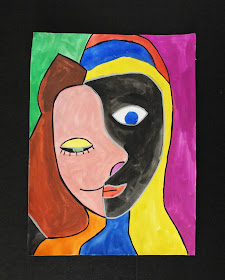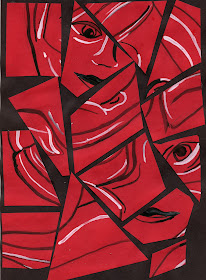The buildings have different widths so we have some 3D interest going on.
MATERIALS REQUIRED:
- canvas or cardboard substrate (base)
- cardboard, chipboard, heavy corrugated cardboard, Styrofoam, or packing material
- Dry Dek or drywall compound (a huge bucket will only cost $20.00)
- wax paper
- household items for texturing, (combs, toothpicks, Lego, straws, etc.)
- acrylic craft paint
- paintbrushes
- assorted screws, washers, whatever excess hardware on hand
- colored paper, book pages, newspaper
- scissors
- Aleene's tacky glue
- moon clip art from "The Graphics Fairy"
- star sequins
- Mod Podge, acrylic medium, or sealer
PROCEDURE:
 Cut some rectangles out of cardboard and chipboard. If you don't have any packing material (I just happen to have some 2 inch wide corrugated cardboard) you can use Styrofoam, even boxes. You can also glue several pieces together to make a thick piece. For the Grade Ones I'll have this already cut into rectangles, triangles and semi circles.
Cut some rectangles out of cardboard and chipboard. If you don't have any packing material (I just happen to have some 2 inch wide corrugated cardboard) you can use Styrofoam, even boxes. You can also glue several pieces together to make a thick piece. For the Grade Ones I'll have this already cut into rectangles, triangles and semi circles.
Lay it out on top of your canvas or background so you know you have enough buildings.
 Apply the drywall compound onto the cardboard. Use a spatula from the hardware store (only 88 cents) or even an old gift card. Apply to just the front for the thin pieces and include the sides for the thicker pieces. You can use some household items for texturing if you want.
Apply the drywall compound onto the cardboard. Use a spatula from the hardware store (only 88 cents) or even an old gift card. Apply to just the front for the thin pieces and include the sides for the thicker pieces. You can use some household items for texturing if you want. You can stick in some washers now if you want or glue them on later after you have painted. I did it both ways. Let dry about 6-8 hrs.
You can stick in some washers now if you want or glue them on later after you have painted. I did it both ways. Let dry about 6-8 hrs. Paint your background with black acrylic paint and let dry.
Paint your background with black acrylic paint and let dry. Splatter on some white paint for stars. With the kids I use a splatter box.
Splatter on some white paint for stars. With the kids I use a splatter box. Paint the buildings with acrylic paint. Let dry. Glue on some windows with colored paper, book pages, or newspaper.
Paint the buildings with acrylic paint. Let dry. Glue on some windows with colored paper, book pages, or newspaper. Glue the buildings onto the background. Add the moon and a few sequin stars.
Glue the buildings onto the background. Add the moon and a few sequin stars. Finally add a coat of Mod Podge, acrylic medium, or your usual sealer for a nice shiny finish.
Finally add a coat of Mod Podge, acrylic medium, or your usual sealer for a nice shiny finish.
See you next time.

















































